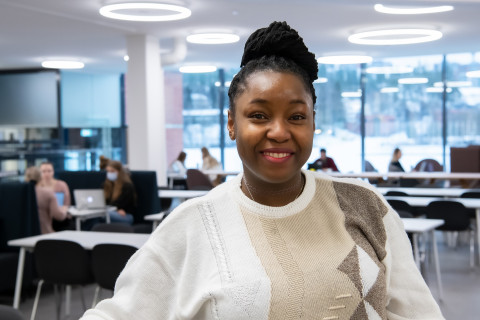Interest in the laws of science led Akuroma George to do research in technical physics.
“The world of physics entails principles and laws that I see as clear foundations for doing research,” says Doctoral Researcher Akuroma George, explaining his interest in physics.
Originally from Nigeria, George has been conducting doctoral research at the Department of Technical Physics in the University of Eastern Finland since spring 2023. The department organises special theme days where students can learn about ongoing research projects and open positions, as well as put themselves forward as prospective research group members. Indeed, George has worked in three different projects at the department.
“Students work on a wide variety of topics within research projects and can independently choose their areas of interest. A summer job in Assistant Professor Isaac Afara’s research group led me to doctoral research.”
George’s doctoral dissertation explores articular cartilage using the wavelengths of near infrared and visible light. The research examines imaging methods for the diagnosis of osteoarthritis.
Enrolling in a Master’s degree programme amidst a pandemic
Akuroma George’s interest in science dates back to his youth, when he realised that he excelled in STEM subjects in school. He started his Bachelor’s degree in Nigeria and finalised it in South Africa.
George applied to the international Master’s Degree Programme in Medical Physics at the University of Eastern Finland in spring 2020 and began his studies amidst the COVID pandemic.
“When I arrived in Finland, the pandemic prevented me from seeing my classmates for a year, except for joint exams. It was very frustrating. In 2022, however, things took a more interesting turn as we were able to attend events and see each other freely.”
Akuroma George has also participated in the activities of the YUFE Alliance formed by European universities and, in the role of a YUFE advisor, he has helped international students with everyday issues upon their arrival at the University of Eastern Finland’s Kuopio Campus for the first time. He can relate well to the practical questions international students arriving in Finland have, which often revolve around familiar topics such as move notifications, work permits, tax cards, bank accounts, and health care.
Becoming a member of an international scientific community
Although it has taken an effort to learn the ropes of daily life in eastern Finland, the international researcher’s integration has been facilitated by the university’s international community and open atmosphere. At the Department of Technical Physics, both Finnish and English are used working languages. The University of Eastern Finland also fosters a flat hierarchy, meaning that staff members can be addressed by their first name, and professors’ doors are open.
International and interdisciplinary contacts are forged naturally between researchers.
“Our research group has a journal club that meets regularly to read publications from different disciplines to discover similarities between them. Conferences, too, are good for networking between colleagues to establish collaborations between laboratories at different universities.”
Akuroma George highlights many good things about working at the University of Eastern Finland, such as good public transportation, student housing close to the campus or near a bus stop, affordable campus lunch restaurants and extensive sports services.
Akuroma George’s life after the PhD is still open: he is pondering between a career in research, and a career in industry as a medical physicist. Working as a medical physicist in Finland requires mastery of the Finnish language, and George has already started learning the language.
“There are many different paths, and I’m sure I’ll find the one that’s right for me,” he concludes.


